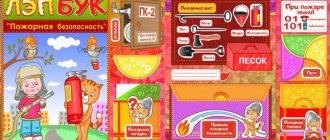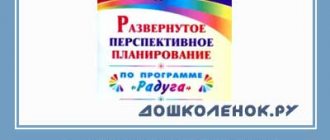MAGAZINE Preschooler.RF
“Formation of the fundamentals of life safety in preschool children.” From work experience.Life in the 21st century poses many new problems, among which the most pressing today is the problem of preserving the health of children and adults, ensuring the safety of the younger generation. The relevance of this topic is due to the objective need to inform children about the rules of safe behavior, their acquisition of experience of safe behavior in everyday life, in nature, the deteriorating health status of preschool children, and the importance of targeted activities in this area by parents and preschool employees. Having determined the theme of the experiment, its main idea, I outlined the main goal of the work: teaching a child the correct behavior at home, on the street, on the road, in transport, when communicating with strangers, interacting with fire hazardous, sharp, piercing objects, animals and poisonous plants ; formation of ecological culture and healthy lifestyle values in preschool children.
In these conditions, the study of the subject of the fundamentals of life safety acquires particular relevance. In this regard, I have become aware of the need to find a mechanism for developing in the younger generation a conscious and responsible attitude towards issues of personal safety and the safety of others. I believe that this training should take place at all stages of a person’s life, and it must begin from preschool age.
Having determined the theme of the experiment, its main idea, I outlined the main goal of the work: – formation in children of the foundations of the safety of their own life activities and the formation of prerequisites for environmental consciousness (safety of the surrounding world) through solving the following tasks:
- Introducing children to the simplest methods of safe behavior in a variety of dangerous situations.
- To form ideas about situations that are dangerous for humans and the natural world and ways of behavior in them.
- Introduce the rules of behavior that is safe for humans and the natural world around them.
- Development of awareness and voluntariness in following the basic rules of safe behavior in everyday life, on the street, in nature, and in communicating with strangers.
- Enriching children's understanding of the main sources and types of danger in everyday life, on the street, in nature, and in communicating with strangers.
- Formation of a culture of healthy and safe lifestyle in preschoolers.
- Formation of knowledge about the rules of safe road traffic as a pedestrian and vehicle passenger.
An analysis of the literature shows that most researchers suggest using game methods and techniques to familiarize children with safety rules, such as didactic games, dramatization games, game problem situations, game modeling, game shells for activities, game characters.
My system of work was created on the basis of the program by N. N. Avdeeva, O. L. Knyazeva, R. B. Sterkina “Fundamentals of the safety of preschool children” , methodological manuals by K. Yu. Belaya “How to ensure the safety of a preschooler” , “Introducing preschoolers to healthy lifestyle and my own observations, my experience working with preschoolers.
Having studied this literature, I came to the conclusion that the formation of conscious behavior is a long process. Work on teaching the basics of safety must be systematic. For it to bring results, one lesson is not enough. Children should receive systematized knowledge and feel part of the world around them. In order to be more competent in this matter, the topic of my self-education is “Preschooler Safety” . Based on the material studied, the knowledge gained, and the skills acquired, I became interested and had the opportunity to organize group work with children.
I have developed long-term planning for working with children to develop the basics of life safety in children.
In the process of working on solving the problems of my methodological topic, I widely use ICT, design methods and gaming technologies.
I work to develop the basics of safety in preschoolers in close contact with the students’ parents. At parent meetings and conversations, parents get acquainted with the system of work of the preschool institution to develop safe behavior in children, and receive advice on the problem of children’s life safety. Through individual conversations, consultations, meetings, and joint entertainment with children and parents, I try to convince the fathers and mothers of our students that it is impossible to demand that a child follow any rule of behavior if adults themselves do not always follow it. Their special parental responsibility is to ensure that there are as few dangerous situations as possible at home. It is necessary to direct the activities of parents in a direction that is consistent with the objectives and content of educational work in the group.
The effectiveness of the experience.
The main goal has been achieved - children’s initial knowledge has been formed, ideas about dangerous and harmful factors, emergency situations have been developed, and life-saving behavior skills have been formed.
After a repeated survey of parents, the following result was obtained: an increase in the knowledge of preschoolers on this topic; increasing your children's vocabulary; changes in the physical, mental, and emotional health of children for the better; changing the child’s attitude towards his own health and the health of other people. Children have become more attentive in everyday life and in nature. Learned how to behave correctly with strangers. They began to pay more attention to hygiene procedures, physical education and sports. Parents noted that their educational level on this topic had also increased; they began to think more about the healthy and safe lifestyle of their family, about the need to observe it not only in kindergarten, but also at home. The work done with children and parents is only part of the interesting work and practical activities. Preventive work to prevent child injuries will always come first. Our children should have a trauma-free childhood.
I consider the result of my work to be good. The main goal has been achieved - the children’s initial knowledge has been formed, they have knowledge of the road alphabet and the culture of behavior on the road and in transport, their understanding of dangerous and harmful factors, emergency situations has been developed, and life-saving behavior skills have been formed.
The most important result in working with children was that they realized that the most important thing for a person is his life and health, so they need to be protected!
LIST OF REFERENCES USED
- Avdeeva N.N., Knyazeva O.L., Sterkina R.B. Safety: A textbook on the basics of life safety for children of senior preschool age. M.: ACT - S.P., 2012.
- Avdeeva, N.N. Basics of safety for preschool children [Text] / N.N. Avdeeva, O.L. Knyazeva, R.B. Sterkina // Preschool education. – 2007. – No. 3. – P.32.
- Almazova, N.I. Cognitive aspects of the formation of intercultural competence when teaching a foreign language at a non-linguistic university. Abstract of thesis. for the job application scientific degree of Doctor of Pedagogical Sciences [Text] / N.I. Almazova. – St. Petersburg, 2009. – 47 p.
- Belaya, K.Yu. How to ensure the safety of preschoolers. Notes on the basics of safety for preschool children. Book for kindergarten teachers [Text] / K.Yu. Belaya, V.N. Zimonina, L.A. Kondrykinskaya. – M.: Education, 2010. – 94 p.
- Bondarevskaya, E.V. Pedagogy: personality in humanistic theories and systems of education: Proc. manual for students of pedagogical universities and IPK students [Text] / E.V. Bondarevskaya, S.V. Kulnevich. - M., 2009. - 560 p.
- Vasilyeva, A.I. Senior kindergarten teacher: A manual for employees of preschool institutions [Text] / A.I. Vasilyeva, L.A. Bakhturina, I.I. Kobitina. - M.: Education, 2010. -143 p.
- Vasilyeva, Ts. Learning safety rules [Text] / Ts. Vasilyeva // Preschool education. - 2005. - No. 2. – P.65-68.
- Golovina, N. Preventive work to prevent injuries in preschoolers [Text] / N. Golovina // Preschool education. - 2006. - No. 3. – P.93-94.
- Gorina, L.N. Modeling the human life safety system in the educational process [Text] / L.N. Gorina, A.A. Kovaleva // News of the Samara Scientific Center of the Russian Academy of Sciences. – 2010. – T.12, No. 5. – P.35-39.
- Gromyko, Yu.V. Concept and project in the theory of developmental education V.V. Davydova [Text] / Yu.V. Gromyko // News of the Russian Academy of Education. - 2010. - No. 2. — P.36-43.
- Dalinina, T.V. Modern problems of interaction between a preschool institution and the family [Text] / T.V. Dalinina // Preschool education. - 2010. - No. 1. — P.41-48. — No. 2. — P.44-49.
- Derkunskaya, V.A. Diagnosis of the health culture of preschool children. Textbook [Text] / V.A. Derkunskaya. – M.: Pedagogical Society of Russia, 2005. – 280 p.
- Dobryakova, V.A. Three traffic lights. Didactic games, leisure evening scenarios. Book for kindergarten teachers [Text] / V.A. Dobryakova, N.V. Borisova, T.A. Panina, S.A. Uklonskaya. – M.: Education, 2009. – 62 p.
- Evdokimova, E.S. Design technology in preschool educational institutions [Text] / E.S. Evdokimov. – M.: TC Sfera, 2006. – 64 p.
- Isaeva, T.E. Classification of professional and personal competencies of a university teacher [Text] / T.E. Isaeva // Proceedings of the international scientific and practical Internet conference “Higher school teacher in the 21st century” . Sat. 4. ‒ Rostov n/a: Rost. state University of Railways, 2009. – pp. 15-21.
- Origins: Basic program for the development of a preschool child [Text] / Ed. L.A. Paramonova, A.N. Davidchuk et al. M.: Karapuz, 2007. - 288 p.
- Klimenko, A.V. Project activities of students: In history lessons [Text] / A.V. Klimenko, O.A. Podkolzina // Teaching history and social studies at school. - 2008. - No. 9. — P.69-75.
- Kogan, M.S. Everyone should know the rules of the road. Cognitive games with preschoolers and schoolchildren [Text] / M.S. Kogan. – Novosibirsk: Sib. Univ. Publishing house, 2006. – 256 p.
- Kuznetsova, T.V. Project activity in the practice of an elementary school teacher [Text] / T.V. Kuznetsova, S.I. Pozdeeva // Pedagogy. – 2006. – No. 10. – P.65-68.
- Markova, A.K. Psychology of professionalism [Text] / A.K. Markova. – M.: International Humanitarian Foundation “Knowledge” , 2006. – 308 p.
- Methodological materials and documents for the course “Fundamentals of Life Safety” : Book. for the teacher [Text] / Comp. A.T. Smirnov, B.I. Mishin; Ed. A.T. Smirnova. - M.: Education, 2011. - 160 p.
- Minkevich, L.V. Recommendations for organizing and conducting pedagogical councils [Text] / L.V. Minkevich // Preschool education. – 2013. – No. 4. – P.39-40.
- On the approval and implementation of federal state requirements for the structure of the basic general education program of preschool education: Order of the Ministry of Education and Science of the Russian Federation of February 23, 2009 No. 655.
- Pakhomova, N.Yu. Method of educational projects in an educational institution [Text] / N.Yu. Pakhomova. - M.: ARKTI, 2009. - 112 p.
- Rainbow: Program and methodological guidelines for the upbringing, development and education of children 5-6 years old in kindergarten / Comp. T.N. Doronova. M.: Education, 2006. - 95 p.
- Stepenenkova, E.Ya. Preschoolers about traffic rules. A manual for kindergarten teachers [Text] / E.Ya. Stepenenkova, M.F. Filenko. – M.: Education, 2009. – 80 p.
- Khromtsova, T.G. Raising safe behavior in the everyday life of preschool children: Textbook [Text] / T.G. Khromtsova. – M.: Pedagogical Society of Russia, 2005. – 78 p.
| Next > |
Thematic week “The ABC of Safety”
Materials and equipment:
multimedia presentation “Fire - friend or foe?”;
recording the sounds of burning flames; musical recording by Khachaturian “Sabre Dance” for the plastic sketch “What is fire like?”; pictures depicting various situations where fire is useful or harmful; plumes for dancing; paraphernalia for relay races: 2 buckets, 2 substitute fire extinguishers, 2 shovels, 2 dolls, 2 children's buckets, 2 children's blankets. Progress:
Introduction to the game situation
. Children are sitting on the carpet. The teacher suggests listening to the recording of sounds and guessing what it is. (The fire is burning). “Guys, what do you think, does a person need fire or not? Is fire our friend or enemy? (As a rule, children answer differently. All answer options are accepted by the teacher. You should try to create a friendly atmosphere for discussion.) Next, the teacher suggests learning as much as possible about fire and then answering this question again.
Main part.
The teacher tells the children the story of the origin of fire, accompanied by a multimedia presentation and involving children in the story. Then he sums it up: “Fire brings many benefits to man. But if people are careless when handling fire, it can cause harm. And then forests burn and animals die (slide show), houses can catch fire and people get hurt (slide).
Did. game “Fire is a friend, fire is an enemy.” Children are divided into two teams. One team chooses pictures where fire helps people, the other where fire causes harm, and justify their choice.
Plastic sketch “What kind of fire is there?” Children dance with the sultans to a musical recording of Khachaturian’s melody “Sabre Dance”, trying to convey the character of music and fire.” After the dance, the teacher asks the children: “What kind of lights were you: good, beneficial to humans, or harmful and dangerous?”
Did game "Yes-no". The teacher invites the children to formulate together the rules for handling fire and behavior in case of fire. If the children agree with the statement, they clap their hands; if they disagree, they stomp their feet. Suggestions could be: if there is a fire in the apartment, you need to quickly hide under the bed; in case of fire, call 01; if you see a fire, you must urgently inform adults and leave the premises; you can quietly take matches and play, etc.
A conversation about the profession of a firefighter is accompanied by a presentation. Children are active participants in the discussion. The teacher asks questions: Who puts out fires? What does a fire truck look like? What kind of person should a firefighter be? (strong, brave, kind, courageous, good, courageous, etc.) How can you put out a fire? (with water, cover with sand or earth, a fire extinguisher, a thick blanket).
Outdoor game "Firefighter Training". Children are divided into two teams. Firefighters must put out the house and save the child from the fire. The first couple takes the “child” doll out of the “burning house” and wraps him in a blanket. The second pair “puts out the fire” with water, using children’s buckets. The third pair is “covering the fire with sand” - imitation of actions using blades. The fourth pair - “extinguishes with a fire extinguisher” - a substitute object (pin) is used.
Summing up, reflection.
The teacher invites the children to answer the question again: Does a person need fire or not? Still, is fire a friend of people or an enemy? Summing up: “Man needs fire; it brings many benefits. Man cannot refuse to use fire. And to avoid trouble, you need to follow the rules of handling fire and always be careful.
Some children's drawings made during Safety Week.
Children's knowledge gained
secured by making
collages based on fairy tales.
“The fairy tale is a lie, but there is a hint in it,
Good fellows have a lesson..."
Quickly take the steering wheel in your hands and start the engine. Let's pump up the tires together and get into the cars together. We press the pedal and the car goes into the distance.
Stop, car, stop, engine! There is a traffic light on the road. The red light comes on - that means there is no way for us! Yellow - be careful!
And the green light is on, which means the path is open again.
open.
Our traffic lights:
from cubes,
designer, mosaic.
In physical education we learned how to fight germs and diseases.
Bibliography.
1. Alyabyeva E.A. Thematic days and weeks in kindergarten: Planning and notes. - M.: TC Sfera, 2005.
2. Afonkin S. When, why and why? St. Petersburg: Lan, 1996.
3.Safety of your baby. A popular guide for children and parents. "Development Academy" 1997.
4. Ivanov Albert The ABC of Safety: How inseparable friends did not burn in the fire;
How inseparable friends did not drown in the water;
How inseparable friends guarded the house;
How inseparable friends crossed the road “Ast-press”, Moscow, 1996.
5. Internet resource: www.maam.ru/obrazovanie/zanyatiya-po-obzh;
www.qooql.ru/search?q.
6. How to ensure the safety of preschoolers: Lesson notes on the basics of safety for preschool children: A book for kindergarten teachers / K.Yu. Belaya, V.N. Zimonina, L.A. Kondrykinskaya, L.V. Kutsakova, S.I. Merzlyakova, V.N. Sakharov. - 2nd ed. - M.: Education, 2000.
7.Lykova I.A., Shipunova V.A. Road ABC. Children's safety: educational and methodological manual for teachers, practical guide for parents. - M.: Publishing House "Tsvetnoy Mir", 2013.
8. Lykova I.A., Shipunova V.A. Dangerous objects, creatures and phenomena. Children's safety: educational and methodological manual for teachers, practical guide for parents. - M.: Publishing House "Tsvetnoy Mir", 2013.
9. Lykova I.A., Shipunova V.A. The ABCs of safe communication and behavior. Children's safety: educational and methodological manual for teachers, practical guide for parents. - M.: Publishing House "Tsvetnoy Mir", 2013



